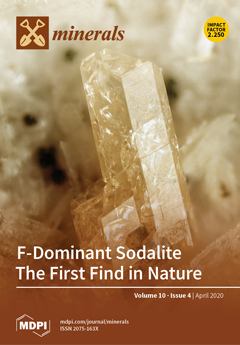Kesebolite-(Ce), ideal formula CeCa
2Mn(AsO
4)[SiO
3]
3, is a new mineral (IMA No. 2019-097) recovered from mine dumps at the Kesebol Mn-(Fe-Cu) deposit in Västra Götaland, Sweden. It occurs with rhodonite, baryte, quartz, calcite, talc, andradite, rhodochrosite, K-feldspar,
[...] Read more.
Kesebolite-(Ce), ideal formula CeCa
2Mn(AsO
4)[SiO
3]
3, is a new mineral (IMA No. 2019-097) recovered from mine dumps at the Kesebol Mn-(Fe-Cu) deposit in Västra Götaland, Sweden. It occurs with rhodonite, baryte, quartz, calcite, talc, andradite, rhodochrosite, K-feldspar, hematite, gasparite-(Ce), chernovite-(Y) and ferriakasakaite-(Ce). It forms mostly euhedral crystals, with lengthwise striation. The mineral is dark grayish-brown to brown, translucent, with light brown streak. It is optically biaxial (+), with weak pleochroism, and
ncalc = 1.74.
H = 5–6 and VHN
100 = 825. Fair cleavage is observed on {100}. The calculated density is 3.998(5) g·cm
−3. Kesebolite-(Ce) is monoclinic,
P2
1/
c, with unit-cell parameters from X-ray single-crystal diffraction data:
a = 6.7382(3),
b = 13.0368(6),
c = 12.0958(6) Å, β = 98.578(2)°, and
V = 1050.66(9) Å
3, with Z = 4. Strongest Bragg peaks in the X-ray powder pattern are: [
I(%),
d(Å) (
hkl)] 100, 3.114 (20-2); 92, 2.924 (140); 84, 3.138 (041); 72, 2.908 (014); 57, 3.228 (210); 48, 2.856 (042); 48, 3.002 (132). The unique crystal structure was solved and refined to
R1 = 4.6%. It consists of 6-periodic single silicate chains along (001); these are interconnected to infinite (010) strings of alternating, corner-sharing MnO
6 and AsO
4 polyhedra, altogether forming a trellis-like framework parallel to (100).
Full article





